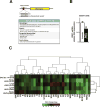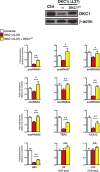H/ACA small RNA dysfunctions in disease reveal key roles for noncoding RNA modifications in hematopoietic stem cell differentiation
- PMID: 23707062
- PMCID: PMC3857015
- DOI: 10.1016/j.celrep.2013.04.030
H/ACA small RNA dysfunctions in disease reveal key roles for noncoding RNA modifications in hematopoietic stem cell differentiation
Abstract
Noncoding RNAs control critical cellular processes, although their contribution to disease remains largely unexplored. Dyskerin associates with hundreds of H/ACA small RNAs to generate a multitude of functionally distinct ribonucleoproteins (RNPs). The DKC1 gene, encoding dyskerin, is mutated in the multisystem disorder X-linked dyskeratosis congenita (X-DC). A central question is whether DKC1 mutations affect the stability of H/ACA RNPs, including those modifying ribosomal RNA (rRNA). We carried out comprehensive profiling of dyskerin-associated H/ACA RNPs, revealing remarkable heterogeneity in the expression and function of subsets of H/ACA small RNAs in X-DC patient cells. Using a mass spectrometry approach, we uncovered single-nucleotide perturbations in dyskerin-guided rRNA modifications, providing functional readouts of small RNA dysfunction in X-DC. In addition, we identified that, strikingly, the catalytic activity of dyskerin is required for accurate hematopoietic stem cell differentiation. Altogether, these findings reveal that small noncoding RNA dysfunctions may contribute to the pleiotropic manifestation of human disease.
Copyright © 2013 The Authors. Published by Elsevier Inc. All rights reserved.
Figures




References
-
- Apffel A, Chakel JA, Fischer S, Lichtenwalter K, Hancock WS. Analysis of Oligonucleotides by HPLC-Electrospray Ionization Mass Spectrometry. Analytical chemistry. 1997;69:1320–1325. - PubMed
-
- Bachellerie JP, Cavaille J. Guiding ribose methylation of rRNA. Trends in biochemical sciences. 1997;22:257–261. - PubMed
-
- Baerlocher GM, Vulto I, de Jong G, Lansdorp PM. Flow cytometry and FISH to measure the average length of telomeres (flow FISH) Nat Protoc. 2006;1:2365–2376. - PubMed
Publication types
MeSH terms
Substances
Grants and funding
LinkOut - more resources
Full Text Sources
Other Literature Sources
Medical
Molecular Biology Databases

